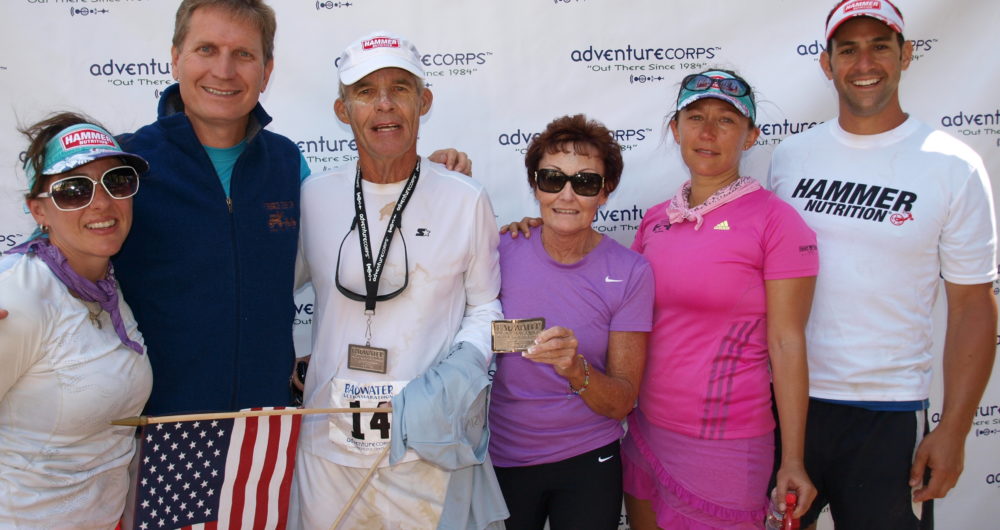Heat Training in the Sauna
By Arthur Webb
Fifteen-Time Finisher: 1998 through 2012, including a Personal Record and new Age Group Record of 33:45:40 at age 70 at his final Badwater 135 in 2012. His stats.
The heat in Death Valley in July is extreme. The official weather station is located at Furnace Creek where it can reach 130 degrees (54C). But, in micro-climates, like the Stovepipe Wells area, it is always hotter. Since running in suffocating heat on 200 degree (93C) pavement presents health and safety issues, health officials and the race staff strongly recommend that all runners do some type of heat training. I rate its importance in the race survival equation equal to, and possibly greater than race pacing, food, and fluid intake.
Check the Badwater University section of this website for other heat-related articles and tips. Any single method or any combination of them will help you acclimate and contribute to a successful trek across Death Valley. For example:
A). Train in the desert (any desert) as presented by Doctor Ben Jones.
B). Simulate heat conditions by running in layers of clothing as suggested by Stephen Simmons.
C) Bake Yourself: Drive around with the windows rolled up and the heater on high. When time and availability was a problem, I used this method during my ½ hour drive home from work. It can get messy, but it does work.
D). Follow my Sauna Training plan outlined here, a key factor during fifteen Badwater finishes:
- The sauna serves two extremely essential functions: First, it prepares the body to deal with the blistering heat in Death Valley. Secondly, according to medical research, a runner acclimated to the heat loses fifty per cent less sweat and sodium.
- Train every day: Although you may have to take a day off to hydrate or rest, a daily blast works best. Dry saunas simulate Death Valley conditions, but if a steam sauna is available use it, at least, one day a week. Sometimes storms lash the Badwater area, and it becomes extremely hot and humid. Fortunately, I have rotated between dry and steam saunas and have been ready for anything. It was effective.
- The goal is to stay in the heat of the sauna for as long as possible: When I rigorously workout in the sauna I must leave it too soon, which defeats the purpose (Remember, at Badwater, you are in sauna-like heat all day with no doors to escape). I have better results sitting on the planks doing a light abdominal workout. I save my harder workout for the daily run, which I do first and then use the hot box. Running after a sauna session is extremely difficult. Save this time for hydrating.
- Note: There are athletes that have favorable results using treadmills and stationary bikes inside the sauna. (The extremely elevated heart rate is a concern and may stress the body too much; what’s mainly necessary is heat adaptation, which can be done without exercise).
- Also Note: Dr. Lisa Stranc-Bliss has had success (Women’s winner Badwater 2007) using an infrared sauna, which she says, “the lower temperatures penetrate deeper….and she can stay in much longer in the 130–145-degree range.”
- Be patient: Most saunas top out at the 160–180-degree range (71-82C). The first few days are the hardest and hottest. After fifteen minutes it becomes overbearing, and it is time to leave. But as time goes by you will be able to stay in longer. By the fourth week, you should be able to manage 30 minutes or more at 180 degrees (82C). I use the sauna at a more relaxed level throughout the year, which helps me ease into the extensive four-week regimen listed below.
- Drink: It is important to hydrate while inside the sauna.
- Note: I usually take in three 2-liter bottles of ice water. One bottle is for replacing liquids copiously sweated out and two bottles are for rinsing the body (acts as a coolant for a minute or so), and together they help you stay in the sauna longer.
- Electrolyte Replacement: I take Endurolytes while in the sauna. (Choose your favorite sodium replacement, but make sure it has a proper balance of all electrolytes, not simply sodium; Ultra Salt by Pure Vitamin Club is also very popular.) Include taking them during your daily runs as well. They restore the potassium, magnesium and sodium that depletes through sweat. I would not run Badwater without them. They keep the system balanced and help prevent nasty cramping issues. They do work.
- Time element: Finding enough sauna time may be a problem because of all the training (and working). Anyway, weeks before the Badwater race everyone has run more than enough mileage, so skip a run or two and just bake in the box. Besides, as the race draws near, heat training becomes much more important.
- Recovery: After the sauna I lay on a bench for about ten minutes as the body continues to sweat. After the elevated heart rate returns to normal levels, it is time for a cool shower and an evening of hydrating. Liquid intake is essential to help keep urine color at optimum race day running levels (light to pale yellow).
***** Important note: I typically ran (and other runners, too) my daily training miles with urine color either in the yellower under saturated levels, and, at times, in the clear urine over saturated levels and rarely noticed a drop in performance. But, running Badwater or any ultra at these red-lining toxic levels for prolonged periods of time (without adjusting water intake) is a one-way guaranteed ticket to a major problems. For greater insight read my article “The Art of Finishing Badwater 135.”
- Heat training in the sauna should take no more than four weeks and usually three are sufficient: When you get unexpected goose bumps at work/home or when it is one hundred degrees (38C) but feels like eighty (27C), you are acclimated. It is best to stop sauna training at least three days before the race. Do not worry; it takes weeks to lose the saunas heat benefits. The last days before are the time to hydrate properly (including electrolytes; don’t make the mistake of drinking excess plain water before – or during – the race.)
10. Sample four-week sauna training:
|
Day
|
Minutes
in Sauna |
Temperature |
|
01
|
15
|
160F / 71C |
|
02
|
15
|
160F / 71C |
|
03
|
15
|
160F / 71C |
|
04
|
15
|
160F / 71C |
|
05
|
20
|
160F / 71C |
|
06
|
20
|
160F / 71C |
|
07
|
20
|
110 / 43C (steam) |
|
08
|
25
|
160F / 71C |
|
09
|
25
|
160F / 71C |
|
10
|
25
|
110F / 43C (steam) |
|
11
|
25
|
160F / 71C |
|
12
|
30
|
160F / 71C |
|
13
|
30
|
160F / 71C |
|
14
|
30
|
160F / 71C |
|
15
|
35
|
160F / 71C |
|
16
|
35
|
160F / 71C |
|
17
|
40
|
160F / 71C |
|
18
|
40
|
160F / 71C |
|
19
|
40
|
160F / 71C |
|
20
|
30
|
110F / 43C (steam) |
|
21
|
45
|
160F / 71C |
|
22
|
30
|
170F / 77C |
|
23
|
40
|
170F / 77C |
|
24
|
45
|
170F / 77C |
|
25
|
30
|
180F / 82C |
|
26
|
35
|
110F / 43C (steam) |
|
27
|
40
|
180F / 82C |
|
28
|
45
|
180F / 82C |
11. Race Day: Wear white shrouded hat and light-colored wicking clothes (white arm and leg sleeves are a bonus). And keep the clothing wet. We use a super-soaker (water gun) and/or large handheld squirt bottles filled with chilly water. I always carry a small (4 oz) squirt bottle filled with icy water that I spray on my face to help cool and refresh (it works). If clothing dries out it may protect you from ultra-violet rays, but they tend to retain heat and you will start overcooking.
That’s my Sauna Training Plan, along with other heat training options. Regardless of the schedule or method you select, any heat training will make running Badwater 135 more tolerable.
Hopefully everyone will complete this incredible race, because crossing the finish line at Badwater 135 is as good as it gets.
Best of luck to all.
Life is Grand
– Arthur Webb (The Grinder)
15 x Badwater Finisher: 1998, 99, 00, 01, 02, 03*, 04, 05, 06, 07, 08, 09, 10, 11, 12
* Honorable mention
Age group (70-79) course record holder 33:45:40 (2012)
Badwater Hall of Fame (2013)
Any questions: Runerof100@aol.com or find me on Facebook.









